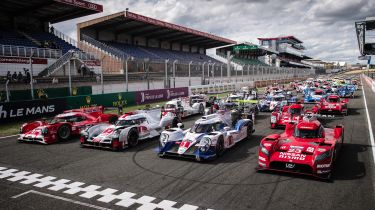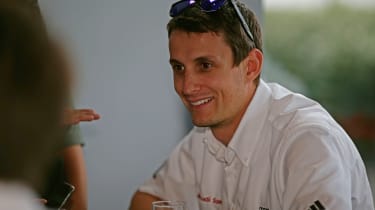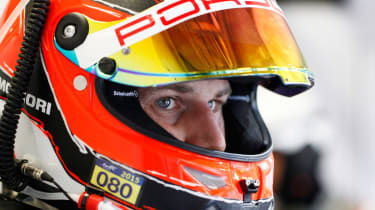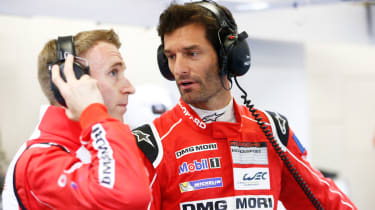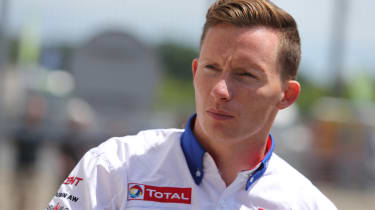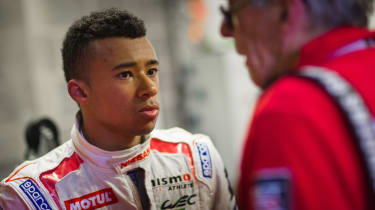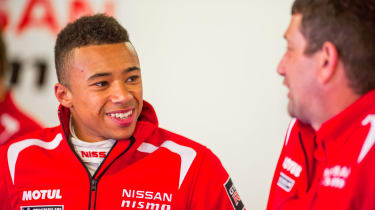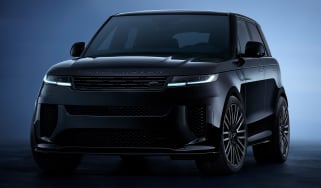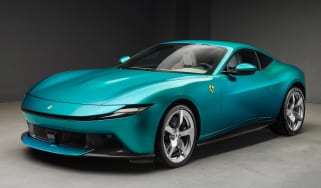Le Mans 24 Hours 2015: your guide to this year's race
We talk to the drivers taking on the legendary Le Mans 24 Hours in 2015, including F1 stars Mark Webber and Nico Hulkenberg
Oliver Jarvis
Cambridgeshire-born Oliver Jarvis, 31, has been an Audi factory driver since 2008 and first contested the Le Mans 24 Hours for the brand in 2010. This is his first year running a full World Endurance Championship (WEC) season for the team.
How important was it to run the car’s low-downforce Le Mans bodywork in race conditions at Spa?
“Very important - we got lots of important information and data, not just about how quick the car is, but how it develops over the duration of a race and whether we have any issues during race conditions. Testing’s great, but there’s a big difference between testing, however realistic you try to make it, and race conditions. It can be silly things like how the car behaves in traffic when you’re behind another car, which is great to learn before you arrive in Le Mans.”
How do you think Audi and Porsche will stack up at Le Mans?
“Porsche have bigger boost out of the corners. But once they’ve used their boost, we’ll then start to catch them up. Hopefully, the higher the speed, the longer the straight, the closer we’ll get to them. Where we really lose out is in very tight corners with a short straight after – that’s where Porsche can boost a little bit and we never have the opportunity to challenge them.”
What parts of the track do you think you’ll have an advantage at?
“Porsche will be very quick out of Arnage and the first and last chicane. I’d like to think we’d have an advantage through the Porsche Curves again. It’s going to be very similar to what we saw at Silverstone, where they were quicker in some parts and we were quicker in others – it should create a fascinating battle. We’ve got to work to our strengths, which at the moment look like a little more downforce and more speed in corners, so we really have to maximise that.”
Have the cars changed much since your Le Mans debut in 2010?
“It’s incredible to look back – when I drove R10, it was a simple car in comparison. There was a steering wheel with a few buttons for the pit speed limiter and the radio. There was very little extra asked of the driver on track. Now you’ve only got to look at the steering wheel and the surrounding cockpit – there are hundreds of options, buttons and commands for the hybrid system – it’s completely changed. But you always have to adapt and change as driver.”
Will qualifying be more important at Le Mans this year?
“Yes – purely because if we’re quicker, like at Silverstone, and if we can stay ahead on the first lap, that gives us an opportunity to pull a gap. If we end up behind the Porsches, then it’s very difficult to pass them. Qualifying isn’t the be-all and end-all, but maybe there’s a little more emphasis this year, as the cars work differently. If we do have better race pace, then if we can start on pole and pull out a gap on lap one, we have much more chance of maximising our race pace and increasing that gap.
Nico Hulkenberg
Force India’s Nico Hulkenberg, 27, becomes the first currently racing Formula One driver to contest Le Mans since Toro Rosso’s Sebastien Bourdais ran for Peugeot in 2009. He’s already had a taste of prototype competition at the Spa WEC race.
Has it been hard to get used to sharing your car with two other drivers?
“It is different, but it’s not too difficult to get used to – I quite like it. It’s a big contrast to F1, here it’s a different game. That’s the format, I knew what I signed up for and I enjoy every moment.”
Can you compare the F1 and WEC hybrid systems?
“To be honest, the final product, what you feel on throttle, is pretty similar. Hybrid systems are quite demanding, you have to manage it a lot, there are lot of instructions from the engineer to manage the battery and system. Both are fun and both are good to use in the race.”
Do you feel you’re driving the car at 100% yet?
“Not yet - I’m still on the learning curve, still learning every time I get in. It’s quite a different tool to my F1 car and requires quite a different driving. At each track I have to adjust and adapt.”
How confident are you about lapping the slower cars?
“As much as I can be. It’s one of the things I really look forward to about sportscar racing. The driver can make a big difference by managing it more efficiently, trying to anticipate what the car in front will do, positioning yourself well and being smart about it.”
What’s you target for Le Mans this year?
“Just to go and do a good job for Porsche and myself. I’m coming here as a beginner with no experience, so it’s going to be tough – I’ll have to learn a lot during the race and adapt and adjust as I go.”
Does the driving technique differ greatly between F1 and the WEC?
“It’s very important to get a good exit from the corner so we can maximise our hybrid boost in a straight line. You don’t want to waste anything momentum to either side like in F1 where you carry more speed into the corner. The two game-changers here are four-wheel drive and the traction control. When you hear endurance, you think about cruising, saving the car and the tyres. Actually I learned quite quickly that it’s very different. Our stints are about two hours, which is more or less an F1 race time, but they’re flat out for every driver lap after lap. The tyres are very consistent and stable, so we can push throughout.”
How do you feel about driving in the dark?
“It’s new to me but I’ve done it in some test at Paul Ricard and Bahrain. It’s something I really enjoy – often I find that I do my best lap times at night. It’s a different atmosphere and a different environment – it feels like it’s just you and your headlights out there – I really like it.”
Mark Webber
Nine-time Grand Prix winner Mark Webber made the move to sportscar racing last year after retiring from Formula One. The 38-year-old Australian previously ran at Le Mans for Mercedes in 1999, but the effort was cut short due to a series of spectacular flips on the high-speed Mulsanne straight.
Porsche has moved from running two to three cars at Le Mans this year. How much of a difference does that make to the overall effort?
“We can feel in the team that it’s hard and takes a lot of energy. Even something like doing an engineering debrief with nine drivers – Audi has been doing that for years but we’re still figuring it out. But it’s important to have another car. We saw last year how easy Audi and Toyota lost one car through a random scenario early in the race. It gives you that extra 33 margin for the win.”
The prototypes have got much quicker this year and are almost F1 pace. Is there such a thing as too fast?
“Le Mans is a dangerous race and track and we all know that. The drivers aware that speeds are high – there’s been some adjustments to the Indianapolis and Porsche corners, but we need to keep the balance and know that every time we get in the car it’s a real test for us – our concentration is at maximum. The race organisers don’t want us to go faster than three minutes 20, but it’s about how we produce the lap time really.”
Are there any lessons learned from 2014 that will be foremost in your mind going into this year’s race?
“I didn’t do much night work ahead of the event so it was important to do that in the race. I was also learning how the track changes, where the rubber builds up – things I never experienced in practice. Once the race is underway, the track is changing so much and that’s experience you can only get once you’ve done a certain number of laps in the race. I’m also looking at where to pass backmarkers, deciding where it’s an option, seeing how they’re behaving, what the different driving standards are like at night. Overall I’m a bit more relaxed this year.”
There seems to be a lot of mutual respect between the prototype drivers – have you found this?
“We know that the cars are very quick and we push each other very hard. There’s a rewarding nature to doing stints against each other for two hours – you get out and say ‘good job mate, I only took three seconds out of you!’ You see the respect there, which is good. We know there has to be respect, because the cars are so fast there’s an element of consequences. There’s respect at the front in F1 too, you’re racing the same five or six guys for four or five years, but you just don’t see each other as much as in sportscars. There, you spend the whole weekend in your own team environment. I sometimes went three races without seeing Lewis face to face for example. Here, we have more time to discuss things and spend time together.”
Nick Tandy
Bedford-born Nick Tandy, 30, started off racing Minis around short oval tracks in the UK as a teenager, but quickly got on the single-seater ladder and then progressed to become a works GT driver for Porsche. This year, he’s been given the chance to race the manufacturer’s hybrid prototype for the first time at Spa and Le Mans.
This is a huge opportunity – what does it mean to you?
“Well, I race wherever Porsche asks me to race, whether its GTs, at the Nurburgring or in America. It’s awesome that I’m getting to race this great cars in one of the best championships in the world, but it’s being part of Porsche in the first place that I’m most proud of.”
How complex is this latest generation of hybrid prototypes to drive?
“Over a lap, especially in dry when you’re not adjusting parameters, there’s not much going on – you’re just driving it as you would any other race car. It’s when you start looking for a difference in how the car is operating, using the hybrid boost differently, or if conditions change, that it becomes very involved. When you’re in and around other cars, there’s a hell of lot going – you’re still doing 300km/h, you’re changing some setting and you’re talking to your crew. Normally it’s not too bad – they’ve done a good job in keeping us as focused on the driving as possible.
What is the car actually like to drive?
“I can’t compare it to anything else I’ve raced – it’s like being shot out of a gun. It picks up speed so quickly, then when the boost stops, it feels so pedestrian – you have ‘only’ 500bhp as opposed to nearly 1,000. It’s a big shock, it accelerates nearly as fast as it stops. But I’ll still enjoy going back to the GTs – a racing car is a racing car, you can have just as much fun in a little Formula Ford as you can with these.”
Mike Conway
Kent’s Mike Conway (31) won the British Formula 3 Championship in 2006, then tested for Honda in F1 and raced IndyCars in the US. He joined Toyota’s sportscar programme as a test and reserve driver in 2014 and was promoted to a full-time race drive for this season.
Toyota didn’t run its Le Mans aerodynamic package at Spa - does that put you at a disadvantage?
“We’ve done quite a lot of testing with the Le Mans aero package, so we’re fairly confident with what we have. It’s interesting to see the two Audis ran in Le Mans spec at Spa – we thought it might just be one. In the wet at Spa, the high-downforce cars seemed quicker and we’re happy with what we’ve done so far.”
How are you feeling going into the big race?
“It’s quite an art driving the hybrid cars and getting the most out of the hybrid systems, so I’m looking forward to getting out on track at Le Mans. You do lots of work in simulators, but it’s never quite the same as doing it for real. So I’m looking forward to that and seeing where we are compared to the competition. Some of the circuit changes look interesting – it could possibly faster, as it’s now wider in places.”
Where do you think Toyota sits in the pecking order?
“Audi looked good with their high-downforce package in Silverstone and Porsche is quick in a straight line with their hybrid boost. Top speed isn’t a problem for us – it’s just how quickly we get there. Our hybrid system should suit Le Mans I think.���
Would you prefer if Toyota was running three cars like Audi, Porsche and Nissan?
“It would be nicer to have another car out there – it just gives you another chance of winning or defending positions. But it’s not an option for us and we won the championship with two cars last year.”
Is there a good atmosphere between all the manufacturer team drivers in the WEC?
“Ever since I stepped into the WEC paddock a couple of years ago, I’ve really enjoyed it. Everyone’s very friendly and you get to know everyone quickly. At the end of the day we all love racing and have a lot of respect for each other.”
Jann Mardenborough
The son of a professional footballer, 23-year-old Jann Mardenborough had no real-world motorsport experience before he won the 2011 edition of the Nissan PlayStation GT Academy competition, which takes the top gamers from the virtual world and gives them the chance to become professional racing drivers on track. He’s one of three British drivers in Nissan’s radical front-engined, front-wheel-drive GT-R LM racer at Le Mans.
As a GT Academy winner, do you think you’re better placed to handle a car as unusual car as the Nissan than a more established driver who might have certain preconceptions?
“Having preconceptions is always wrong in motorsport. We’re the biggest example of that, showing everyone it can be done. I’ve seen what Ben [Bowlby, Nissan's designer] has done in the past with the DeltaWing and at Lola. Our car is very different, but he’s an established engineer and I trust him. It’s fulfilling to know he trusts me with the car, too. Someone who’s stayed in the same category for a long time maybe wouldn’t be able to adapt as easily as us, but as a driver one of the best traits you can have is to be adaptable, driving different cars in different conditions all the time.”
What’s the visibility like from the cockpit?
“I’m not happy with it, but then no-one in any of the LMP1 cars is! It’s always difficult to see our from where you sit in these cars, we’re to the right, so we have the A-pillar right next to us. The car being so long isn’t an issue, but the wheel covers a lot of our view when we turn right, so we have to sit as high as we can – I’m right on the limit. It’s the same for everyone, but it’s just a fact of prototypes. It would be better if we could sit in the centre of the car, but Le Mans rules state there has to be room for two people inside – theoretically at least!”
How does your approach change compared to a regular rear-wheel-drive racing car?
“It’s about adapting to understeer and understanding it – not only from a driving perspective but also from an engineering and setup perspective. What you ask the engineers for is often very different to what you’d ask for in a rear-wheel-drive car if you were trying to rectify the same.
"Driving-wise, what you do with your feet is different. The steering is very similar, you try to be as smooth as you can. But how you come off the brake is different and you pick up the throttle a little earlier than you would in a conventional car. You start to pick up on things after lots of laps in testing – you try things and understand what works and what doesn’t.”
Darren Cox
Darren Cox heads up Nissan’s NISMO motorsport division and was responsible for the company’s experimental DeltaWing and ZEOD entries at Le Mans in 2012 and 2014, building up to this year’s full entry alongside the other major car makers.
There have been rumours that you won’t be running the car’s hybrid system at Le Mans – is this true?
“We will run hybrid system, but we do have the ability to turn it off. If you believe some other rumours, Audi ran a lot of 2013 without its hybrid system and it didn’t do too badly! But we’ve got half an eye if not more on 2016, so we’ve got to do as much running as we possibly can. If that means running solely on petrol, then that’s what we’ll do and that’s the philosophy that Audi took in 2013. We’re going to learn a huge amount this year.”
Is there a mega-quick qualifying lap in the car?
“Absolutely not, for two reasons: one, we haven’t got the tyres and two, we haven’t got the time. We’ve concentrated on long runs with Michelin. Obviously the car is very different to the other manufacturers’. When Porsche came in, they could lean on what Michelin had learned from running with Audi all those years. The way our car deploys its power and steers on the front wheels means the tyre construction and compounds are very different.
"So you won’t see us going for a ‘banzai’ lap – if I was a betting man, I’d say Porsche is going to be on pole. We’ve got to get each driver’s night qualifying laps in and set the car up for changeable conditions and temperatures. Our job in qualifying is to get the car ready for the race, so judge us at the end of our first stint – have we got the strategy right and can we stretch the fuel usage and tyre life? And if it’s raining, throw away the form book!”
Why is the Nissan programme based in the US rather than Europe like your rivals?
“There’s a lot of underutilised motorsport talent in terms of individuals and suppliers. The IndyCar season effectively runs from May until September and the rest of the year, people are twiddling their thumbs. People have gone over there to do different championships and now they’re underutilised.
"In the UK, you’re always going to be fighting against F1 for the best people. There’s a group of very good guys in the US that we’ve been able to recruit. We’re based in the old Forsythe Champ Car facility in Indianapolis and we use GM’s fantastic test track at Bowling Green in Kentucky, which is four hours from our base.
"It has a 1.2-mile straight and replicas of various Le Mans corners and the weather goes from cold to wet and hot. We also have full use of Nissan’s Arizona testing facility, which has a five-mile bowl. And for the flyaways, Indianapolis is a DHL hub, so flying stuff from there to Europe is straightforward. When the championship was Silverstone, Spa, then Le Mans, you could move to Silverstone for three months and run the first races out of there - which we’ve done.
"Now we’ve got the Nurburgring race after Le Mans, which we’re going to have to treat as a flywaway from the US, but before, it would’ve been perfect to do the Le Mans prep from Europe, then the flyaways from the US, but I think the pros still outweigh the cons.”
What’s the aim for Nissan at Le Mans this year?
“With half an eye on 2016, the more laps we do the better. Last year, one Porsche finished 11th and the other retired, but they got a car home, learned a huge amount about the car and the tyres, and the drivers got more time on track. Our aim has to be getting one car home, but we’re all racers – we’re not there just to tool around. We know we’re not going to win or get a podium, but we want to be credible in terms of pace. Changeable conditions will suit us – we think the car has an advantage in low-grip conditions and we don’t know what the tyres are going to do. We could surprise a few people with our tyre management and we have lots of upsides coming for 2016: rear-axle hybrid deployment and further tyre development.”
Find a car with the experts

